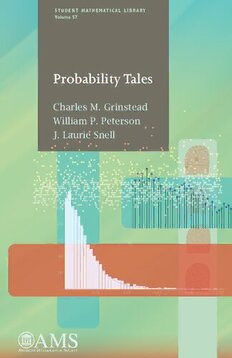
Probability Tales PDF
Preview Probability Tales
STUDENT MATHEMATICAL LIBRARY Volume 57 Probability Tales Charles M. Grinstead William P. Peterson J. Laurie Snell Probability Tales STUDENT MATHEMATICAL LIBRARY Volume 57 Probability Tales Charles M. Grinstead William P. Peterson J. Laurie Snell American Mathematical Society Providence, Rhode Island Editorial Board Gerald B. Folland Brad G. Osgood (Chair) Robin Forman John Stillwell 2010 Mathematics Subject Classification. Primary 60–01, 62–01. For additional information and updates on this book, visit www.ams.org/bookpages/stml-57 Library of Congress Cataloging-in-Publication Data Grinstead,CharlesM.(CharlesMiller),1952– Probabilitytales/CharlesM.Grinstead,WilliamP.Peterson,J.LaurieSnell. p.cm. —(Studentmathematicallibrary;v.57) Includesbibliographicalreferencesandindex. ISBN978-0-8218-5261-3(alk.paper) 1.Probabilities. 2.Stochasticprocesses. I.Peterson,WilliamPaul. II.Snell, J.Laurie(JamesLaurie),1925– III.Title. QA274.G765 2011 519.2—dc22 2010038517 Copying and reprinting. Individual readers of this publication, and nonprofit libraries acting for them, are permitted to make fair use of the material, such as to copy a chapter for use in teaching or research. Permission is granted to quote brief passagesfromthispublicationinreviews,providedthecustomaryacknowledgmentof thesourceisgiven. Republication,systematiccopying,ormultiplereproductionofanymaterialinthis publicationispermittedonlyunderlicensefromtheAmericanMathematicalSociety. Requests for such permission should be addressed to the Acquisitions Department, AmericanMathematicalSociety,201CharlesStreet,Providence,RhodeIsland02904- 2294USA.Requestscanalsobemadebye-mailtoreprint-permission@ams.org. (cid:2)c 2011bytheauthors. Allrightsreserved. PrintedintheUnitedStatesofAmerica. (cid:2)∞ Thepaperusedinthisbookisacid-freeandfallswithintheguidelines establishedtoensurepermanenceanddurability. VisittheAMShomepageathttp://www.ams.org/ 10987654321 161514131211 To our wives Probability Tales Contents Preface vii Chapter 1. Streaks 1 §1. Introduction 1 §2. Models for Repeated Trials 4 §3. Runs in Repeated Trials 6 §4. Statistical Tests on Repeated Trials 9 §5. Data from Various Sports 24 §6. Runs in the Stock Market 71 §7. Appendix 79 Chapter 2. Modeling the Stock Market 97 §1. Stock Prices 97 §2. Variations in the Price of a Stock 103 §3. The Normal Distribution and Power Laws 106 §4. Distribution of Returns 114 §5. Independence of Returns 128 §6. Is the Power Law Exponent Intrinsic? 136 §7. Appendix 139 v vi Contents Chapter 3. Lotteries 149 §1. Rules of the Powerball Lottery 149 §2. Calculating the Probabilities of Winning 152 §3. What is Your Expected Winning for a $1 Ticket? 157 §4. Does a Ticket’s Expected Value Ever Exceed $1? 165 §5. What Kind of Numbers Do Lottery Buyers Choose? 168 §6. Finding Patterns 173 §7. How Often is the Jackpot Won? 179 §8. Other Lotteries Pose New Questions 181 §9. Using Lottery Stories to Discuss Coincidences 182 §10. Lottery Systems 184 §11. Lottery Stories from Chance News 185 §12. Lottery Questions from John Haigh 189 Chapter 4. Fingerprints 191 §1. Introduction 191 §2. History of Fingerprinting 191 §3. Models of Fingerprints 198 §4. Latent Fingerprints 203 §5. The 50K Study 217 Answers to John Haigh’s Lottery Questions 225 Bibliography 231 Index 235 Preface This book was begun when two of the authors decided that their collaboration on their introductory probability book was both pro- ductive and fun. We cast about to find some other project on which we could continue this collaboration. At the same time, all three of the authors were working on Chance News, which is an ongoing website containing reviews of news and journal articles pertaining to probability and statistics in the real world. It was decided that we shouldtrytowriteabookinwhichwewouldtakesomeofourfavorite articles in Chance News and revise and expand them. The result is not exactly what was originally planned. Instead of having many short chapters on a variety of subjects, the present book consists of four chapters in which we go into some depth on the coveredtopics. Infact,itisthisdepththatwethinkmakesthisbook different than other books that cover applications of probability and statistics to the real world. In the first two chapters, we use some ideas from calculus. Much of the more technical mathematics has been placed in appendices so as not to break the flow of the chapters. We think that even if a reader has not studied calculus, he or she will be able to read and understand most of the material in these chapters. In particular, one vii viii Preface can gain much insight in these chapters from the numerous graphs found therein. Ourfirstchapterconcernstheideaofstreaks. Manyparticipants in and observers of sports believe that individuals and teams can be “hot” or “cold.” For example, a basketball player who has made many consecutive field goals is frequently described at the time as having a “hot hand.” It turns out that in many sports, the observed streakscanbeshowntofitaverysimplecoin-tossingmodel. Inother words, coins (fair or otherwise) that are flipped repeatedly exhibit the same kinds of streaks, with the same distributions of lengths of these streaks as those observed in sports. The reader will note that we are not saying that such streaks do not exist, but rather that it is not necessary to posit a model that is any more sophisticated than a simple coin-tossing model to explain these streaks. The second chapter introduces the reader to some aspects of the U.S.stockmarket. Thisisanareainwhichavastamountofresearch has been conducted. We explain how the important class of proba- bility distributions known as power laws can help in understanding the movements of stock prices. Thethirdchapterisconcernedwithlotteries. Wetakethereader through the calculations that are necessary to understand the prob- abilities of winning various prizes in a typical lottery. We use the Powerball lottery as an example. We also consider the effects that income tax, present value, and possible sharing of the prize have on the value of a lottery jackpot. The last chapter contains a short history of fingerprinting and discussessomeoftheproblemswiththeuseoffingerprintsinfighting crime. These problems are still extant and defy easy solutions. Wethinkthatalmostallofthematerialinthisbookisaccessible to those who have had one semester of calculus (some of the mate- rial in the appendices requires some knowledge of power series) and much of it is accessible to all interested readers. We hope that the
